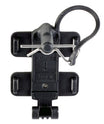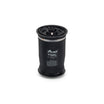
Whiteline Caster Correction Radius Rod To Chassis Audi A4 1996-2001

- Caster Correction Radius Rod to Chassis
- Adjustment: Adds +/-0.5deg
- Position: Front
ALIGNMENT SETTINGS : WHAT ARE THE BEST ONES?
The simple answer is that there is no such thing!
I know we have probably given more information here than most people wanted, but even this only scratches the surface of the available information and variables that need to be considered when contemplating optimum wheel alignment settings.
The most important thing and something we can not stress enough is the fact that alignment settings are NOT an absolute truth that can be held up as an undisputed rule. It is a dynamic process with the "correct value varying from driver to driver, car to car not to mention the driving environment.
DYNAMIC & STATIC : WHAT ARE YOU TALKING ABOUT?
Typically used when discussing wheel alignment and geometry. By this, Whiteline are referring to the difference in alignment angles between a stationary and a moving vehicle. That is, the same vehicle will typically have different caster, camber and toe readings when it is moving compared to when the alignment was done in static form in the workshop.
In an ideal world, all wheel alignments would be done on a dynamic wheel aligner but these are expensive and quite rare. This concept is very important, as the only suspension angles that really matter are those present while the vehicle is moving (dynamic). What is done to the vehicles alignment while the vehicle is stationary, (static) is a process of trying to predict the levels of change while the vehicle is moving and setting the angles according to these predictions.Whiteline puts a great deal of emphasis on the dynamic geometry so rigorous road testing is essential to ensure that the predictions are valid.
- Camber
- Caster
- Toe
- Geometry
CAMBER: WHAT IS IT?
Camber is the inclination of the wheel from the vertical when viewed from the front. When the top of the wheel leans out you have positive camber, lean in equas negative camber.
Static negative camber is used to compensate for body roll, body distortion and tyre roll under when cornering. Stiffer bodies and tyre sidewalls are in and unnecessary suspension compliance is out. Therefore the previous requirements for large amounts of static negative camber are disappearing. Whiteline strut braces are good for maintaining camber angles under cornering loads as they further minimise body flex.
Its important to highlight the fact that camber settings are ultimately a personal thing. That is, Whiteline can provide an indicative range to start from but the final number will depend on your driving style, average driving conditions, tyre size and many other things. You need to start with a relevant number, then monitor tyre wear and compensate if necessary.
Whiteline have a range of camber adjusting products available to achieve the optimum settings.
CASTER: WHAT IS IT?
Caster is the backward or forward tilt of the steering axis. Vehicle manufacturers are aware of the advantages of caster and as each new model is released the amount of caster specified increases.
Why, because the disadvantages of high levels of castor are being overcome. Rack and pinion steering means less play, lower Ackerman levels, smaller scrub radius (zero is now very common), better and lower profile radial tyres means less sidewall deflection and higher tolerance to greater slip angles. But the greatest obstacle, that of heavy steering effort, has all but disappeared with the universal acceptance of power steering.
High levels of positive caster equate to dynamic negative camber on turn when you need it most. Whiteline continues to put heavy emphasis on additional positive caster when designing new suspension packages
Toe
If you were able to view the front tyres of a vehicle from above the car, you would expect them to look exactly parallel to each other. In fact, they rarely are. The difference in distance between the front edge of the tyres and the rear edge is called toe. Toe describes how close to parallel the two tyres are, and whether they are toed-in (closer at the front of the tyre) or toed-out (closer at the rear of the tyre). The goal of toe is to provide proper tyre wear through various driving conditions. The amount of toe your suspension is set to varies by the drive layout of your vehicle, driving preference, and car's handling characteristics.
On a rear-wheel-driven car, acceleration forces on the tyre tend to push the front tyres back slightly in the wheel well. Static toe-in will result in a zero-toe situation at speed. For a front-wheel-driven vehicle, the front wheels will pull themselves forward in the wheel wells under acceleration. This happens because as the (driven) front wheels claw for traction, they pull themselves forward, dragging the rest of the car along. For this situation, static toe-out will result in a zero-toe condition at speed. Assuming that the rest of the suspension is correctly aligned and maintained, and the tyres properly inflated, toe-in will result in additional understeer for the car. In a corner the inside front tyre will turn at less of an angle than the outside tyre. Additionally, excessive toe-in will result in premature tyre wear through feathering, and increased fuel consumption. Conversely, toe-out will result in additional oversteer for the vehicle. This occurs as the inside front tyre turns at a greater angle than the outside tyre. Thus, in a corner, the inside tyre is trying to turn even more than the heavily-loaded outside tyre. Excessive toe-out will also result in premature tyre wear due to feathering, and increased fuel consumption.
Anti- Geometry
Anti features in suspension systems are a characteristic that can be used to influence the stiffness of the front or rear suspension under traction forces(under braking or accelerating). The individual terms are relatively straightforward and self-explanatory with the anti reducing or totally restricting the characteristic (lifting or diving). In the front suspension there may be levels of anti-dive during braking and anti-lift during accelerating (assuming traction to the front wheels is present), similarly in the rear there could be anti lift during braking and anti-squat during acceleration.
It should also be noted that these characteristic can also be reversed into a pro characteristic (as in pro-lift at the front under braking). Anti features can only be implemented under the influence of the braking or accelerating forces at the wheels, for example a rear wheel drive vehicle cannot have an anti-lift characteristic in the front (as there is no drive to the front wheels).
With the ALK fitted to the Subaru WRX, a softer suspension will be present during braking and accelerating. This will help traction, as the wheel will be able to track the ground more precisely. Also in terms of balance the front end will have a proportionally lower roll resistance during traction or braking, aiding in reducing the power understeer effect that is present in these cars.
Vehicle Fitments:
| Year | Make | Model | Submodel |
|---|---|---|---|
| 1998 - 2005 | Audi | A4 | Avant |
| 1996 - 2014 | Audi | A4 | Base |
| 2001 | Audi | A4 | Basico, Avant Confort, Avant Luxury |
| 2007 - 2008 | Audi | A4 | Cabrio S Line, Cabrio Elite |
| 2003 - 2009 | Audi | A4 | Cabriolet |
| 2001 - 2004 | Audi | A4 | Confort |
| 2015 - 2016 | Audi | A4 | Komfort, Premium, Premium Plus |
| 2006 | Audi | A4 | Limited Edition |
| 2001 - 2014 | Audi | A4 | Luxury |
| 2015 | Audi | A4 | Prestige |
| 2004 - 2008 | Audi | A4 | S Line |
| 2005 - 2007 | Audi | A4 | S Line Sport, Elite |
| 2001 - 2016 | Audi | A4 | Sport |
| 2005 - 2016 | Audi | A4 | Trendy |
| 2008 - 2014 | Audi | A4 | Trendy Plus |
| 2003 - 2006 | Audi | A4 | Vangard, Cabrio |
| 1998 - 2012 | Audi | A4 Quattro | Avant |
| 1996 - 2014 | Audi | A4 Quattro | Base |
| 2004 - 2009 | Audi | A4 Quattro | Cabriolet |
| 2001 | Audi | A4 Quattro | Confort |
| 2006 - 2007 | Audi | A4 Quattro | DTM |
| 2005 - 2014 | Audi | A4 Quattro | Elite |
| 2015 - 2016 | Audi | A4 Quattro | Komfort, Technik, Trendy Plus, Progressiv |
| 2002 | Audi | A4 Quattro | Le Mans |
| 2002 - 2016 | Audi | A4 Quattro | Luxury |
| 2013 - 2016 | Audi | A4 Quattro | Premium, Premium Plus |
| 2015 | Audi | A4 Quattro | Prestige |
| 2005 - 2008 | Audi | A4 Quattro | S Line |
| 2010 - 2016 | Audi | A4 Quattro | Sport |
| 2008 | Audi | A4 Quattro | Trendy, S Line Sport |
| 2006 | Audi | A4 Quattro | Vangard |
| 1997 - 2000 | Audi | A6 | Avant |
| 1997 - 2011 | Audi | A6 | Base |
| 2003 - 2004 | Audi | A6 | Confort |
| 2006 - 2012 | Audi | A6 | Elite |
| 2002 - 2012 | Audi | A6 | Luxury, Premium |
| 2012 | Audi | A6 | Premium Plus |
| 2007 - 2010 | Audi | A6 | Sport |
| 1998 - 2011 | Audi | A6 Quattro | Base, Avant |
| 2005 - 2011 | Audi | A6 Quattro | Elite |
| 2001 - 2011 | Audi | A6 Quattro | Luxury |
| 2003 - 2006 | Audi | A6 Quattro | S Line |
| 1997 - 1999 | Audi | A8 | Base |
| 1997 - 2003 | Audi | A8 Quattro | Base |
| 2000 - 2003 | Audi | A8 Quattro | L |
| 2007 - 2008 | Audi | RS4 | Base |
| 2008 | Audi | RS4 | Cabriolet |
| 2003 | Audi | RS6 | Base |
| 2001 - 2008 | Audi | S4 | Avant |
| 2000 - 2016 | Audi | S4 | Base |
| 2004 - 2009 | Audi | S4 | Cabriolet |
| 2014 - 2016 | Audi | S4 | Prestige, Premium Plus |
| 2015 - 2016 | Audi | S4 | Technik, Progressiv |
| 2002 - 2003 | Audi | S6 | Avant |
| 2002 - 2011 | Audi | S6 | Base |
| 2001 - 2003 | Audi | S8 | Base |
| 2000 | Volkswagen | Passat | 4 Motion |
| 2003 - 2005 | Volkswagen | Passat | GL |
| 2004 - 2005 | Volkswagen | Passat | GLS TDI, GL TDI |
| 2001 - 2005 | Volkswagen | Passat | GLX 4 Motion, GLS 4 Motion |
| 1996 - 2005 | Volkswagen | Passat | GLX, GLS |
| 1996 - 1997 | Volkswagen | Passat | TDI, GLX VR6 |
| 2002 - 2005 | Volkswagen | Passat | V6 4Motion |
| 1999 - 2005 | Volkswagen | Passat | V6, 1.8T |
| 2002 - 2004 | Volkswagen | Passat | W8 |


























